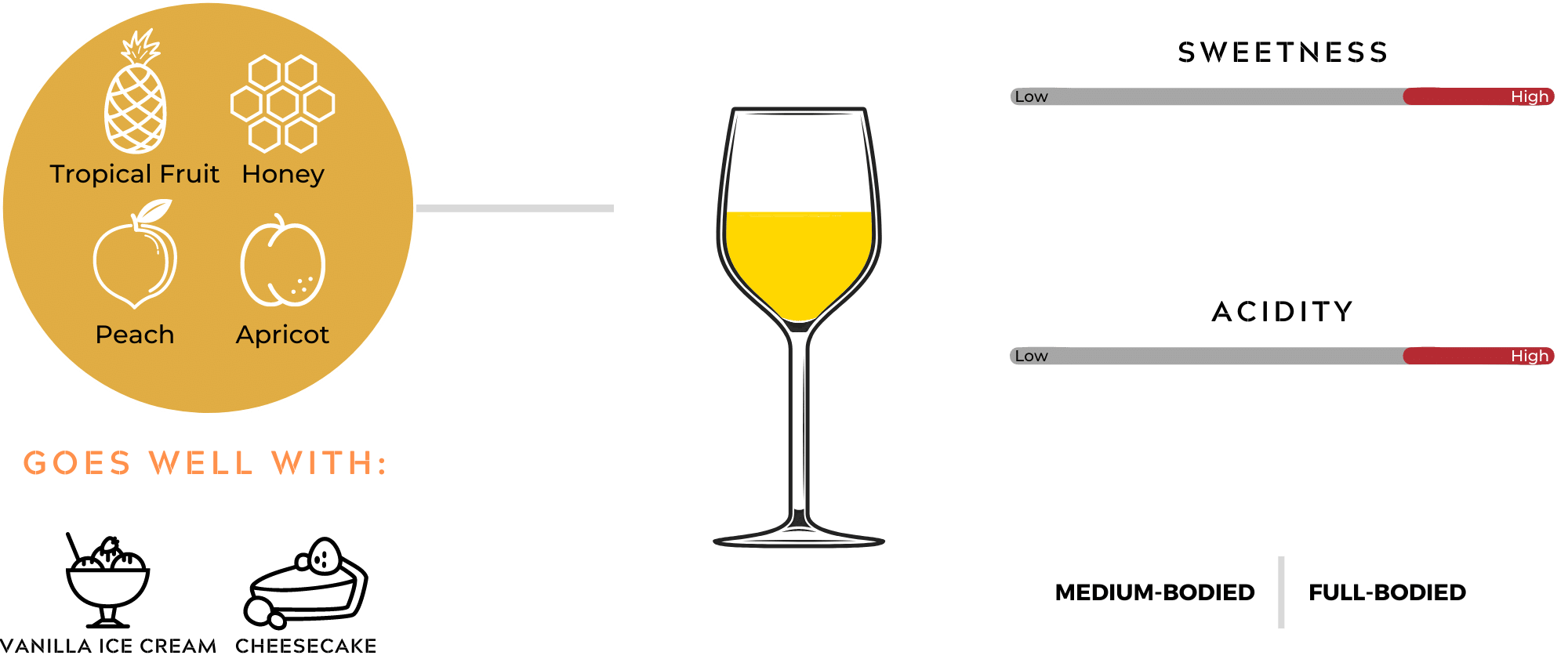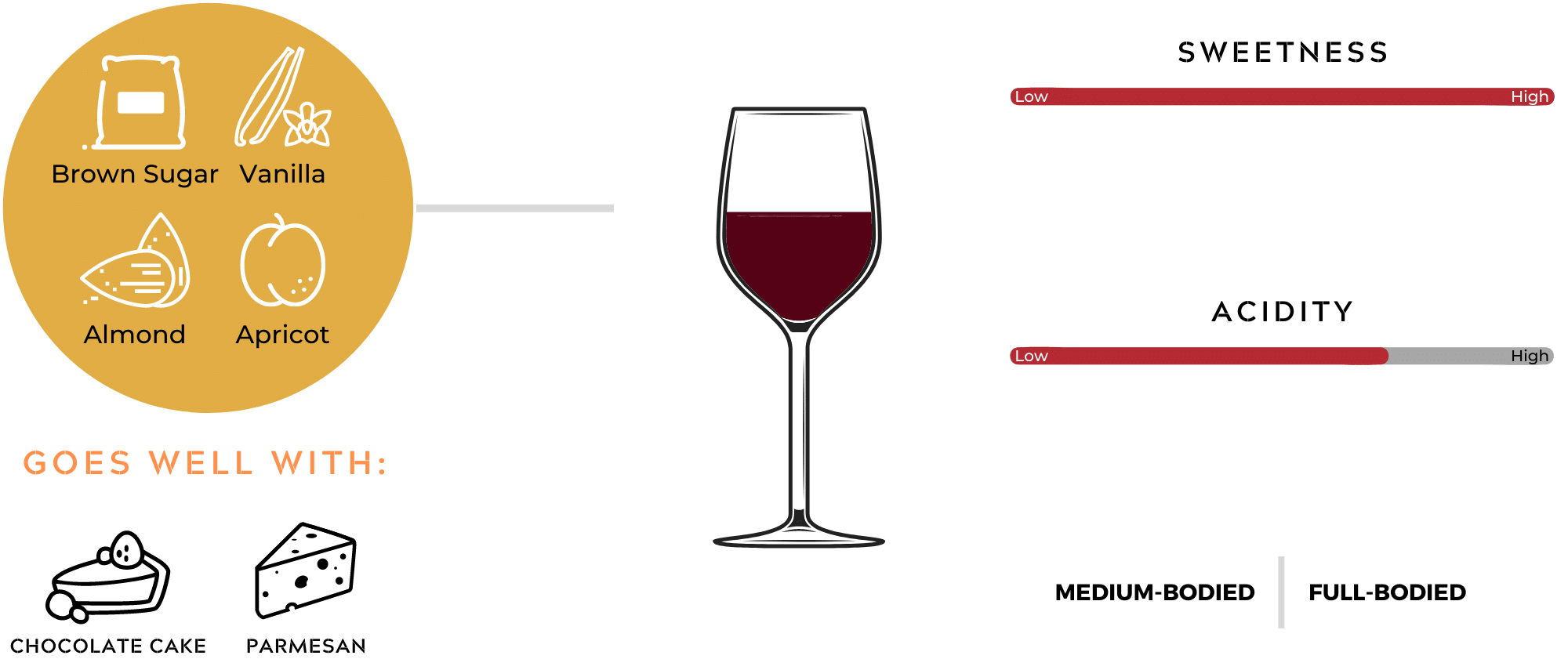Fortified and dessert wines are considered to be some of the oldest and most presitigious types of wine available, with many examples found the world over that are incredibly complex in both their production process and historical development.
With so many being able to be explored, we've chosen to focus on the slightly lesser-known varietals of fortified and dessert wine in this quick guide to each one, where you'll be able to discover more about their expected flavour profile and optimal food pairing options.
Jump to a section of the page using the jump-to-section menu above, otherwise, be sure to consider the other wine guides availble through the main menu above, for those who wish to explore those that are more prominent.
Although many would consider fungus growing on grapes as being something that winemakers would be terrified of, some actually work hard to ensure that the botrytis cinerea fungus does appear on their crops.
The reason for this is that this particular strain of fungus, also called “Noble Rot”, when managed correctly, reduces the water content of the grapes on the vine, whilst still maintaining the grapes inherent sugar levels.
This results in grapes that contain significantly higher concentrations of sugar in the pressed juice, allowing for the production of far sweeter wines.
In addition to adding higher levels of sweetness, Noble Rot also adds further layers of additional flavour to the wine, including honey, beeswax, and ginger.
For more on this topic and how they’re produced, read this in-depth article on the production process for botrytis wines.
The grapes most commonly used in the production of Noble Rot or botrytised wines are almost always white wine varietals, including riesling, sémillon, sauvignon blanc, muscadelle, and gewürztraminer.
Three of the most famous examples of botrytised dessert wines are easily those from the Sauternais region in France, those from various wine growing regions in Australia, and finally, those from the Tokaj wine growing region in Hungary.
Although these wines are characterised by their higher levels of sweetness, this is often balanced out by crisp and refreshing levels of acidity, making them enjoyable when served well chilled during the warmer months.
Specific flavours present in these wines often include peaches, apricots, nuts, honey, beeswax, and other dried fruits, which is often present in the well aged and darker varieties.
When matching botrytis wines with food, it’s often recommended to serve them well chilled alongside foie gras, cream-based desserts, such as cheesecake, or heavier style fruit-based desserts.
Ice wine, or eiswein as it’s often called in Europe, is a style of sweet dessert wine that is made in extremely cold climates such as Canada, Austria, and Germany from grape varietals such as riesling, vidal, and cabernet franc.
Because these and some other high acidity grape varietals are used, the sweetness of the resulting wine is made easier to bear by contrasting it with the naturally higher levels of acidity found in the fruit.
To explain the production process of ice wines as simply as possible, the grapes are grown in freezing cold areas where the water inside the grapes is frozen and the grapes then pressed, ensuring only very concentrated amounts of grape juice and sugar are extracted from the grapes prior to fermentation.
As red or white grape types can be used to produce bottles of ice wine, colour variations can occur, with many ranging in shades from pale yellow or gold to light red or pink.
Ice wines are characterised by their very high levels of sweetness and medium to full body, with white grape styles often possessing flavours of honey, tropical fruits, peach, and apricot, and red grape styles tasting more commonly of strawberry and sometimes gentle spice.
When it comes to pairing food, much care needs be taken in order to ensure that the extremely sweet taste found in the wine is matched with an appropriately flavoured dish.
Bearing this in mind, ice wines can match well with fruit-based desserts, cheesecake, vanilla ice cream, dark chocolate, cheeses such as gorgonzola and roquefort, and rich mains, such as foie gras, as all of these food types can either complement or contrast with the sweetness and acidity in the wine.
To learn more about this fascinating type of wine, consider this in-depth guide.
Bottles of Madeira, named after the Atlantic island that they’re exclusive to, are types of fortified dessert wine that come in a variety of different flavours and ages classifications.
Similar to other types of fortified dessert wine, it is possible to find Madeira made in a dry, medium-dry, medium-sweet, or sweet style.
To learn more about the particular styles of Madeira that can be found, read this article.
The grape varietals that are commonly used in the production of Madeira include verdelho, sercial, boal, malvasia, terrantez, bastardo, and tinta negra mole, with others, such as moscatel, listrao, complexa, and triunfo, being permitted for use but done so far less regularly.
Whilst many bottles of Madeira are often blends of various grape types, it is possible to find premium examples made from a single grape varietal, which makes it easier to get a quick understanding of the anticipated flavour profile of the wine.
Generally speaking, sercial grapes produce a dry style Madeira, verdelho grapes a more medium-dry wine, boal grapes a moderately sweet style Madeira, and malvasia grapes typically produce an oily sweet bottle of Madeira.
Bottles made with some of the other grape varietals, such as bastardo and terrantez, are much rarer to find today due to their limited cultivation on the island but typically result in moderately dry style Madeira wines.
Outside of the grape type used, the flavour profile and quality of the Madeira wine is greatly influenced by the length of time it has been aged for, with it being possible to get wines aged for a minimum of three years right up to multi-vintage blends of twenty to thirty year old Madeira.
Some of the prominent flavours present often include caramel, hazelnut, peach, orange peel, smoke, and many examples of various fresh or dried fruit.
Dry style sercial Madeiras are often served chilled alongside finger food and starters, including olives, garlic, or salads with vinaigrette sauces.
Moving along the scale, medium-dry verdelho Madeira wines are often served with a variety of finger food options, including smoked salmon or cottage cheese, as well as main courses, such as curry or grilled chicken dishes.
Bottles of medium-sweet boal Madeira, on the other hand, are often best matched with aged cheeses, lamb dishes, or any dish that contains a lot of herbs or exotic spices.
Finally, sweet style malsavia Madeira can be sublimely matched with strong blue cheeses, hotly spiced dishes, and dark chocolate.
Marsala, which is similar to Sherry and Madeira in that it can range from dry to sweet in its taste and style, is a fortified wine from the Italian island of Sicily.
It can be made with a number of different white or red grape varietals, including nero d’avola, grillo, inzolia, or pignatello, just to name a few, producing bottles of wine that can come with a range of colours, levels of sweetness, and prominent flavours.
Effectively separating bottles of marsala can be achieved along three main traits, including how long they're aged for, they're colour, and how sweet they are, all of which is usually indicated on the label.
A particular bottle can range in its levels of sweetness from dry, semi-sweet, to sweet, it can be coloured gold, amber, or ruby, and it can have five different age classifications, beginning at minimum one year and going right up to more than ten years.
Most bottles of marsala produced and sold fall into the minimum one year ageing grade, with these often being used as cooking wine, although some premium and complex examples of marsala, which are aged for a minimum of ten years, are ideally consumed as a sipping beverage.
Although the wines can be either dry or sweet in their style, some of the common flavours present across all of them includes brown sugar, vanilla, apricot, and other sweet and savoury notes, with the wines potentially being medium to heavy bodied.
To learn more on the flavour profiles of each of the styles that exist, consider this guide.
When pairing these wines with food, pair any bottle of dry marsala with salty or strongly flavoured food, such as olives, parmesan cheese, or salted nuts.
When it comes to pairing bottles of sweet style marsala, pair them with chocolate-based desserts or roquefort cheeses.
Muscat grapes, which can come in over 200 individual varietals and are used to produce wines of varying styles, textures, tastes, and colours, are perhaps most famously used in the creation of various sweet dessert and fortified wines.
The colours of these grapes and their resulting wines can go from white to brown to black, however, no matter the colour, the grapes always create wines with a highly aromatic and perfumed sweet floral aroma.
Muscat grape varietals are also considered to be some of the oldest ever domesticated, with different examples of muscat-based wines being produced all over the world, including Australia, Portugal, Spain, Italy, South Africa, and France.
The muscat grape varietals most commonly used in the production of wine are the muscat blanc à petits grains varietal, Muscat of Alexandria, Muscat of Hamburg, and Muscat Ottonel.
The two most renowned examples of wines produced by these grapes include the family of vin doux naturel wines from France and the liqueur muscats from Rutherglen in Victoria, Australia, which are both examples of fortified dessert wine.
The vin doux naturel wines produced in France are characterised by their lusciously sweet flavour profile and bright yellow to gold colouring, making them best served well chilled, so as to bring out the fresh, fruity, citrus, and overall clean flavours in the wine.
The liqueur muscats from Rutherglen, however, are usually darkly coloured and intensely flavoured wines that are often aged for varying amounts of time, producing flavours that often include sweet raisins, fruit cake, orange peel, mocha, and nuts.
The French style and more gold to yellow coloured muscat wines can be paired with many fruit-based desserts, rich main courses such as foie gras, or salty blue cheeses like roquefort.
The darker and more strongly flavoured Rutherglen muscats, on the other hand, match well with rich chocolate or caramelised fruit desserts, although many winemakers suggest that they are usually best enjoyed on their own.
For more food pairing options, explore the pairing guides in this article.
There's a bottle of fortified and dessert wine out there for everyone. Here are some of the brands and bottles that we recommend you look out for the next time you're browsing online or in-store.
Sherry is a complicated & often misunderstood drink. Here we explore all of the ways that it can be enjoyed & how you can pick the right bottle & type for you.
Ever wanted to know what wines to pick when looking for something sweet? We help you satisfy your craving for something sweet when browsing in a bottle shop or bar.
Curious about Liqueur Muscats? In our illustrated guide for beginners, we uncover what makes them so special, including how they taste & match with food.




